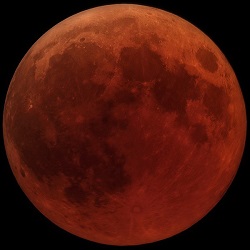A lunar eclipse occurs when the Sun, the Earth, and the Moon are aligned and the Earth casts a shadow across the Moon that can be seen by a viewer on Earth. During a total lunar eclipse, the Sun, the Earth, and the Moon line up perfectly and the Earth's shadow fully covers the Moon, resulting in "totality"; in a partial lunar eclipse, the Sun, the Earth, and the Moon are not perfectly aligned and the Earth's shadow covers only part of the Moon; and during a penumbral lunar eclipse, only the faint outer edge of the Earth's shadow falls on the Moon, resulting in a very subtle dimming of the lunar disc.
 Unlike during a total solar eclipse, when totality is visible from Earth only along a very narrow path for just a few short minutes, a total lunar eclipse can be seen by almost everyone on the nighttime side of the Earth for up to almost two hours. While a solar eclipse requires special eclipse safety glasses or viewers, a lunar eclipse can be viewed safely with just the naked eye.
Unlike during a total solar eclipse, when totality is visible from Earth only along a very narrow path for just a few short minutes, a total lunar eclipse can be seen by almost everyone on the nighttime side of the Earth for up to almost two hours. While a solar eclipse requires special eclipse safety glasses or viewers, a lunar eclipse can be viewed safely with just the naked eye.
A total lunar eclipse is sometimes referred to as a "blood moon" due to the reddish tint exhibited by the Moon during totality. Although the Earth blocks all direct sunlight from striking the Moon, a small amount of indirect light reaches the Moon after passing around the edge of the Earth. After Earth's atmosphere filters and refracts this light, scattering non-red wavelengths, it's reflected back from the Moon to the Earth with a reddish hue. This occurs for the same reason that the sky turns red during a sunrise or sunset.
It's not uncommon for people to confuse the difference between a solar eclipse and a lunar eclipse but the two are entirely different astronomical events. A solar eclipse is the obscuration of the Sun by the Moon; a lunar eclipse is the obscuration of the Moon by the Earth. The name of the eclipse type (solar or lunar) refers to the body being obscured. A lunar eclipse can only occur during a full Moon, when the Moon is on the opposite side of the Earth from the Sun; a solar eclipse can only occur during a new Moon, when the Earth is on the opposite side of the Moon from the Sun.